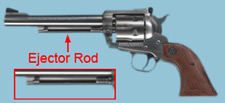- 01: Introduction
- 02: History
- 03: Propellants, Firearms, and Ammunition Development
- 04: Modern Firearms Manufacture
- 05: Small Arms Ammunition
- 06: Evidence Handling Procedures
- 07: Equipment and Instrumentation
- 08: Examination of Firearms
- 09: Cartridge and Shotshell Examination
- 10: Characterization and Evaluation of Fired Projectiles
- 11: Bullet Comparison and Identification
- 12: Gunshot Residue and Distance Determination
- 13: Toolmark Identification
- 14: Communicating Results
- Resources


Single-Action Revolvers
Home > Examination of Firearms > Handguns > Single-Action Revolvers

Single-action Ruger revolver .357
Single-action revolvers require manual cocking of the hammer before sufficient force on the trigger releases the firing mechanism. When the hammer is pulled to the rear (cocking) an internal hand or pawl rotates the cylinder clockwise or counterclockwise, moving the next chamber into alignment with the barrel and firing pin. The hammer then locks into place along with the cylinder. Pulling the trigger releases the hammer, driving the firing pin to detonate the cartridge. Older models can be placed in a safe mode by pulling the hammer slightly to the rear; the hammer locks in place, keeping the firing pin from resting on an unfired cartridge case.
The cylinder of the single-action revolver is usually held in place by a removable pin; a loading gate is located on the right side of the firearm. By opening the loading gate and placing the hammer in an unlocked position, the cylinder can be rotated to ensure that all cylinders are empty. To the front of the chamber (located below the barrel), an ejection rod is used to eject fired cartridge cases from the cylinder. Some single-action revolvers do not have an ejection rod system and require the removal of the cylinder to remove the cartridge cases.




